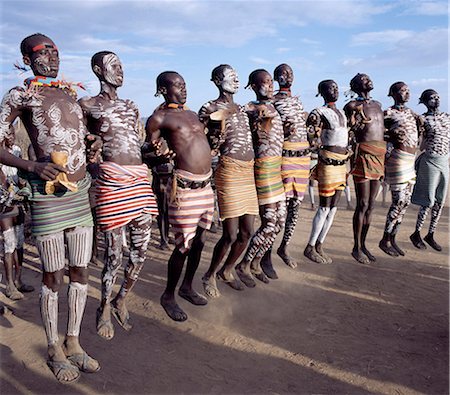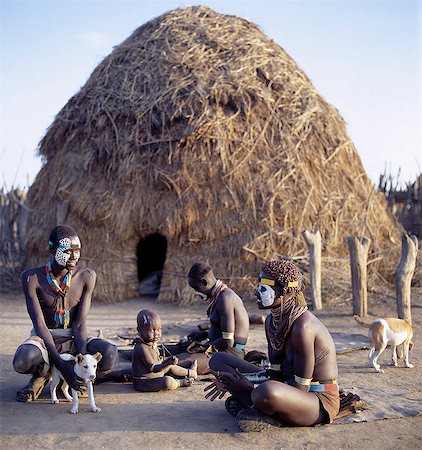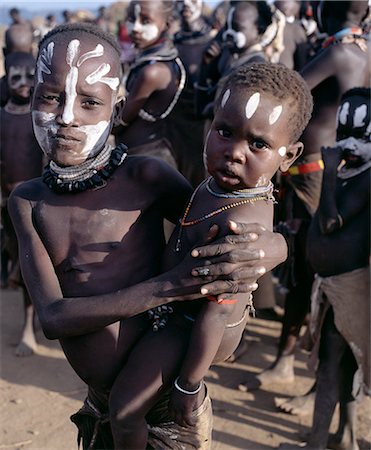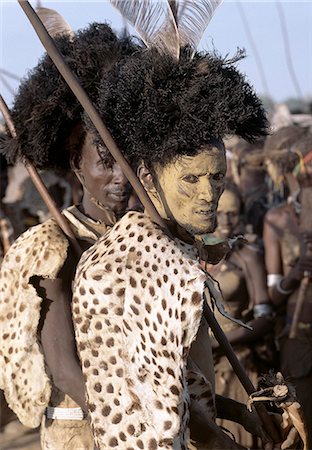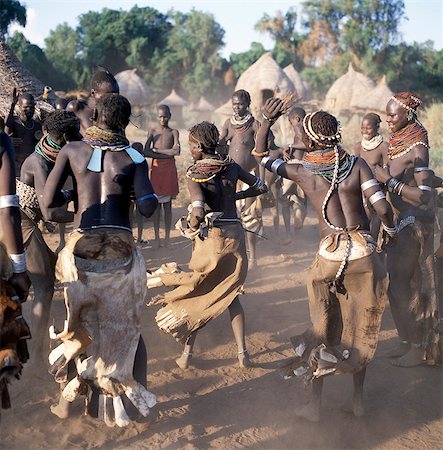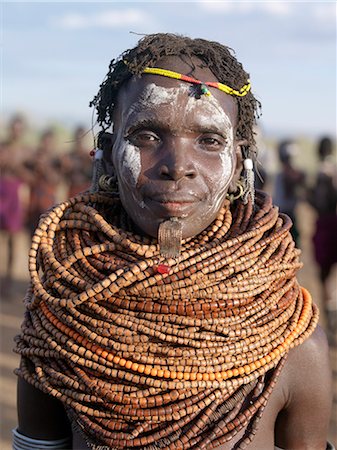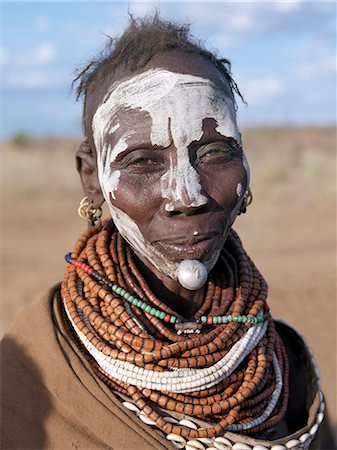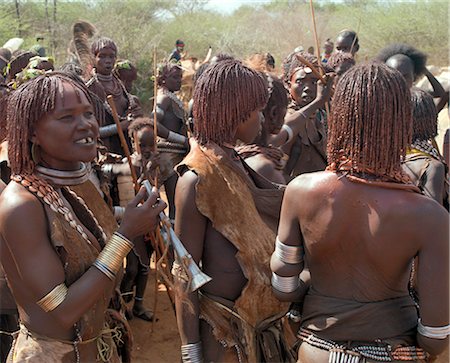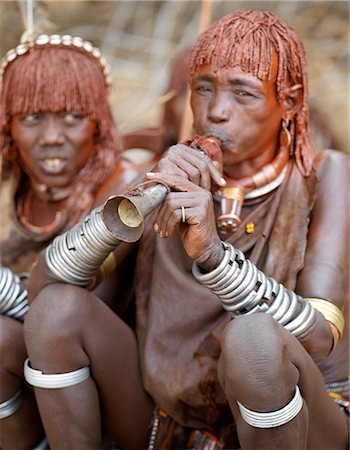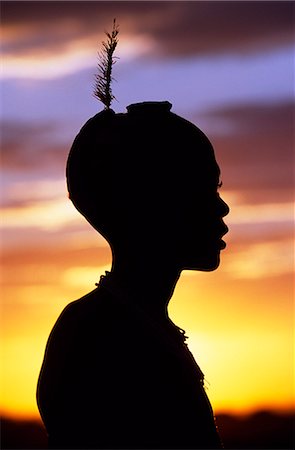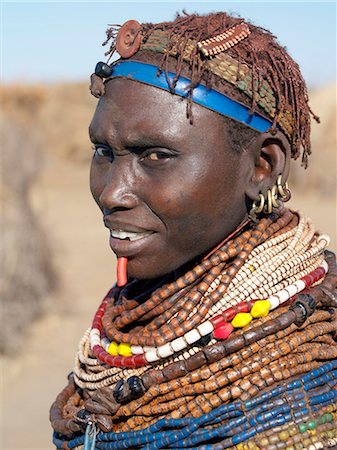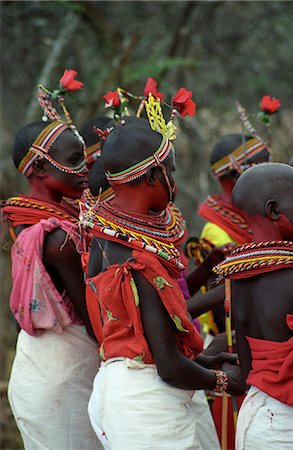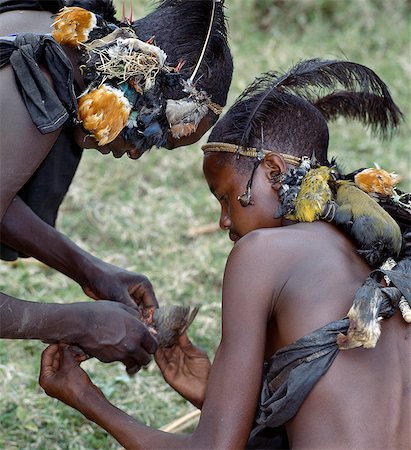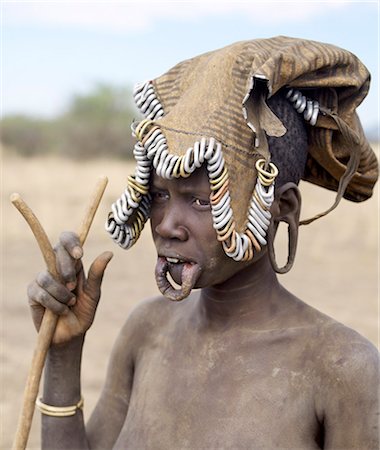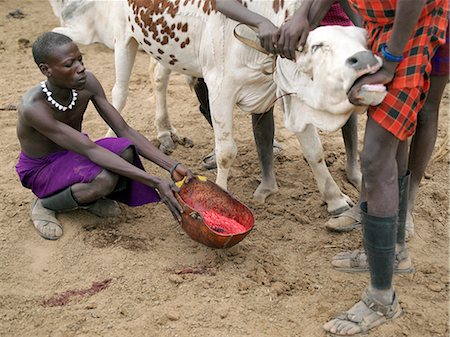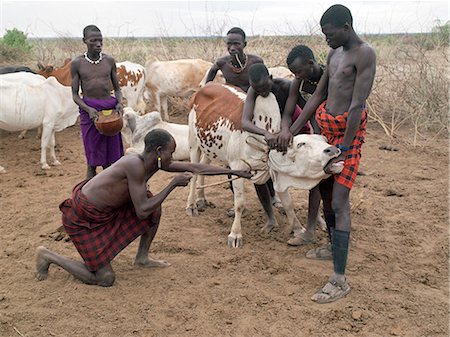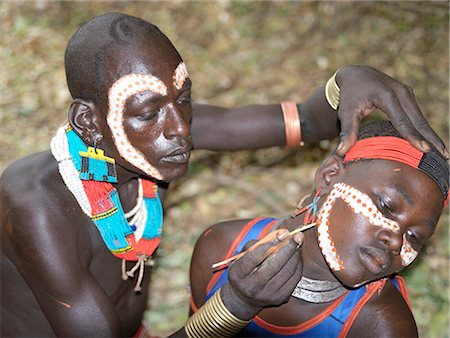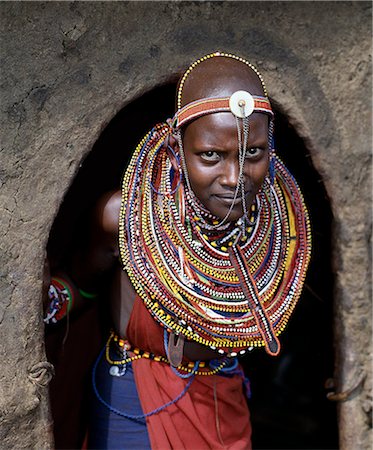-
Karo men paint each other in preparation for a dance in the village of Duss. A small Omotic tribe related to the Hamar,who live along the banks of the Omo River in southwestern Ethiopia,the Karo are renowned for their elaborate body painting using white chalk,crushed rock and other natural pigments.
Con derechos protegidos
-
A Karo women stands in the doorway to her hut in the village of Duss. A small Omotic tribe related to the Hamar, who live along the banks of the Omo River in southwestern Ethiopia, the Karo are renowned for their elaborate body painting using white chalk, crushed rock and other natural pigments. In addition to painting her face she has decorated her body with whorls of goat hair tied by leather co
Con derechos protegidos
-
A young Karo girl in the doorway of her hut in the village of Duss. A small Omotic tribe related to the Hamar,who live along the banks of the Omo River in southwestern Ethiopia,the Karo are renowned for their elaborate body painting using white chalk,crushed rock and other natural pigments.
Con derechos protegidos
-
A Dassanech girl braids her sister's hair at her village in the Omo Delta. Much the largest of the tribes in the Omo Valley numbering around 50,000,the Dassanech (also known as the Galeb,Changila or Merille) and Nilotic pastoralists and agriculturalists.
Con derechos protegidos
-
An elder of the Karo tribe,a small Omotic tribe related to the Hamar,who live along the banks of the Omo River in southwestern Ethiopia. The Karo are renowned for their elaborate body painting using white chalk,crushed rock and other natural pigments. This man also has a clay hairdo typical of tribal elders. Like most adult males he carries a rifle.
Con derechos protegidos
-
A Karo woman with her face painted in preparation for a dance in the village of Duss. A small Omotic tribe related to the Hamar, who live along the banks of the Omo River in southwestern Ethiopia, the Karo are renowned for their elaborate body painting using white chalk, crushed rock and other natural pigments. She is wearing a goatskin apron and carries a leather belt decorated with cowrie shells
Con derechos protegidos
-
A Dassanech woman winnows grain by pouring it from her metal tin and letting it fall onto a calfskin. Much the largest of the tribes in the Omo Valley numbering around 50,000,the Dassanech (also known as the Galeb,Changila or Merille) and Nilotic pastoralists and agriculturalists.
Con derechos protegidos
-
Two young Karo girls stand in front of the massive trunk of a fig tree. A small Omotic tribe related to the Hamar,who live along the banks of the Omo River in southwestern Ethiopia,the Karo are renowned for their elaborate body painting using white chalk,crushed rock and other natural pigments.
Con derechos protegidos
-
An elder of the Karo tribe,a small Omotic tribe related to the Hamar,who live along the banks of the Omo River in southwestern Ethiopia. The Karo are renowned for their elaborate body painting using white chalk,crushed rock and other natural pigments. This man also has a clay hairdo typical of tribal elders. Like most adult males he carries a rifle.
Con derechos protegidos
-
Two young Dassanech boys sport elaborate clay hairdos at their settlement alongside the Omo River. Much the largest of the tribes in the Omo Valley numbering around 50,000,the Dassanech (also known as the Galeb,Changila or Merille) are Nilotic pastoralists and agriculturalists.
Con derechos protegidos
-
In the late afternoon, Nyangatom villagers enjoy singing and dancing. As groups of men take centre stage to jump high in the air, women and girls sing, clap to a rhythm, and move slowly towards the men. Children enjoy the excitement in the background.The Nyangatom are one of the largest tribes and arguably the most warlike people living along the Omo River in Southwest Ethiopia.
Con derechos protegidos
-
In the late afternoon, Nyangatom villagers enjoy singing and dancing. As groups of men take centre stage to jump high in the air, women and girls sing, clap to a rhythm, and move slowly towards the men. Children enjoy the excitement in the background.The Nyangatom are one of the largest tribes and arguably the most warlike people living along the Omo River in Southwest Ethiopia.
Con derechos protegidos
-
Karo men excel in body art. Before a dance, they will decorate their faces and torsos elaborately using local white chalk, pulverised rock and other natural pigments. While older men style their hair with clay, young men prefer to braid theirs.Every man carries a wooden stool, which doubles as a pillow at night.The Karo are a small tribe living in three main villages along the lower reaches of the
Con derechos protegidos
-
Karo men excel in body art. Before a dance, they will decorate their faces and torsos elaborately using local white chalk, pulverised rock and other natural pigments. While older men style their hair with clay, young men prefer to braid theirs.Every man carries a wooden stool, which doubles as a pillow at night.The Karo are a small tribe living in three main villages along the lower reaches of the
Con derechos protegidos
-
Karo men excel in body art. Before a dance, they will decorate their faces and torsos elaborately using local white chalk, pulverised rock and other natural pigments. While older men style their hair with clay, young men prefer to braid theirs.Every man carries a wooden stool, which doubles as a pillow at night.The Karo are a small tribe living in three main villages along the lower reaches of the
Con derechos protegidos
-
A young Dassanech girl holds her little brother. She wears a leather skirt with an elaborate fringe of wooden and metal tassles. Much the largest of the tribes in the Omo Valley numbering around 50,000,the Dassanech (also known as the Galeb,Changila or Merille) are Nilotic pastoralists and agriculturalists.
Con derechos protegidos
-
A Karo woman wears an elaborate headdress made from the wing-cases of beetles and a cape of calf skin fringed with cowrie shells. A small Omotic tribe related to the Hamar,who live along the banks of the Omo River in southwestern Ethiopia,the Karo are renowned for their elaborate body painting using white chalk,crushed rock and other natural pigments.
Con derechos protegidos
-
A Karo woman wears an elaborate headdress made from the wing-cases of beetles and a cape of calf skin fringed with cowrie shells. A small Omotic tribe related to the Hamar,who live along the banks of the Omo River in southwestern Ethiopia,the Karo are renowned for their elaborate body painting using white chalk,crushed rock and other natural pigments.
Con derechos protegidos
-
An elder of the Karo tribe sits with his wife and child. A small Omotic tribe related to the Hamar,who live along the banks of the Omo River in southwestern Ethiopia,the Karo are renowned for their elaborate body painting using white chalk,crushed rock and other natural pigments. This man also has a clay hairdo typical of tribal elders. Like most adult males he carries a rifle.
Con derechos protegidos
-
A young Dassanech girl holds her little brother. She wears a leather skirt with an elaborate fringe of wooden and metal tassles. Much the largest of the tribes in the Omo Valley numbering around 50,000,the Dassanech (also known as the Galeb,Changila or Merille) are Nilotic pastoralists and agriculturalists.
Con derechos protegidos
-
A Nyangatom girl weaves a grass basket. The Nyangatom or Bume are a Nilotic tribe of semi-nomadic pastoralists who live along the banks of the Omo River in south-western Ethiopia.
Con derechos protegidos
-
A Nyangatom woman stands with her baby on her hip beside her grass hut in his temporary camp. Nyangatom married women wear elaborately beaded skirts which reach the ground at the back and often have panels of different coloured calkfskin sewn into the tail The Nyangatom or Bume are a Nilotic tribe of semi nomadic pastoralists who live along the banks of the Omo River in south western Ethiopia.
Con derechos protegidos
-
In the late afternoon, family and friends sit outside a high dome roofed Karo home.The Karo excel in body art. Before a dance, they will decorate their faces and torsos elaborately using local white chalk, pulverised rock and other natural pigments. The polka dot or guinea fowl plumage effect is popular.
Con derechos protegidos
-
A Nyangatom woman grinds sorghum using two stones. Typical of her tribe,she wears a heavily beaded calfskin skirt,multiple layers of bead necklaces and metal bracelets and amulets. The Nyangatom or Bume are a Nilotic tribe of semi-nomadic pastoralists who live along the banks of the Omo River in south-western Ethiopia.
Con derechos protegidos
-
A Nyangatom warrior has painted his body and face in preparation for a dance. Most adult males carry rifles both as status symbols and in case of cattle raids or disputes with neighbouring tribes. The Nyangatom or Bume are a Nilotic tribe of semi-nomadic pastoralists who live along the banks of the Omo River in south-western Ethiopia.
Con derechos protegidos
-
A Nyangatom girl churns butter in a gourd suspended in the entrance to her hut. Typical of her tribe,she is wearing multiple layers of beads in necklaces,and an elaborately beaded calfskin skirt. The Nyangatom or Bume are a Nilotic tribe of semi-nomadic pastoralists who live along the banks of the Omo River in south-western Ethiopia.
Con derechos protegidos
-
Nyangatom men their faces and bodies with stylised patterns using natural pigments obtained from chalk,ochre and crushed rock prior to a dance. The young men then form a circle linking arms and take it in turns to dance around the inside of of the circle. The Nyangatom or Bume are a Nilotic tribe of semi-nomadic pastoralists who live along the banks of the Omo River in south-western Ethiopia.
Con derechos protegidos
-
A Borana man at Mega in southern Ethiopia wears a phallic Kallaacha on his forehead. Made of cast aluminium and ivory or bone,the Kallaacha is worn during the tribe's initiation and gada age-grade ceremonies. The pastoral Borana live either side of the southern Ethiopian/northern Kenya border and form a large and important group of the Oromo-speaking cluster of tribes.
Con derechos protegidos
-
A Nyangatom woman wears multiple layers of beads in necklaces, an elaborately beaded calfskin skirt and metal bracelets, amulets and anklets. She is standing beside a temporary beehive construction of sticks, grass and leaves built to provide shade for her goats. The Nyangatom or Bume are a Nilotic tribe of semi-nomadic pastoralists who live along the banks of the Omo River in south western Ethio
Con derechos protegidos
-
The Karo of the Lower Omo River excel in body art. They decorate their faces and torsos elaborately using local white chalk, pulverised rock and other natural pigments. Even young children daub their faces before a dance.The Karo are a small tribe living in three main villages along the lower reaches of the Omo River in southwest Ethiopia.
Con derechos protegidos
-
A Dassanech man in full tribal regalia participates in a dance during a month long ceremony. He wears a cheetah skin draped on his backs and a black ostrich feather headdress. He dances holding a long stick and a simulated shield.His face is smeared with mud giving him a singular appearance.
Con derechos protegidos
-
Men and women dance during a month long Dassanech ceremony. The men wear leopard, cheetah or serval cat skins draped on their backs and black ostrich feather headdresses. The women, dressed in skins, hang a single black and white colobus monkey skin down their backs.
Con derechos protegidos
-
A Karo woman sits with child. A small Omotic tribe related to the Hamar,who live along the banks of the Omo River in southwestern Ethiopia,the Karo are renowned for their elaborate body painting using white chalk,crushed rock and other natural pigments. Typically for a Karo woman,the mother has ochred her hair in tight ringlets and has a ring through her bottom lip.
Con derechos protegidos
-
A lively Nyangatom dance is enjoyed by villagers in the late afternoon.The elevated houses in the background are both homes and granaries, which have been built to withstand flooding when the Omo River bursts its banks The Nyangatom are one of the largest tribes and arguably the most warlike people living along the Omo River in Southwest Ethiopia.
Con derechos protegidos
-
A Nyangatom woman wears numerous strands of beads made from wood.The Nyangatom are one of the largest tribes and arguably the most warlike people living along the Omo River in Southwest Ethiopia. They form a part of the Ateger speaking people a cluster of seven eastern Nilotic tribes to which the Turkana of Northern Kenya and the Karamajong of Eastern Uganda belong.
Con derechos protegidos
-
A Nyangatom woman wears numerous strands of beads made from wood.The Nyangatom are one of the largest tribes and arguably the most warlike people living along the Omo River in Southwest Ethiopia. They form a part of the Ateger speaking people a cluster of seven eastern Nilotic tribes to which the Turkana of Northern Kenya and the Karamajong of Eastern Uganda belong.
Con derechos protegidos
-
A Nyangatom woman wears numerous strands of beads made from wood.The Nyangatom are one of the largest tribes and arguably the most warlike people living along the Omo River in Southwest Ethiopia. They form a part of the Ateger speaking people a cluster of seven eastern Nilotic tribes to which the Turkana of Northern Kenya and the Karamajong of Eastern Uganda belong.
Con derechos protegidos
-
A Nyangatom woman dries sorghum and other corn in the vicinity of her elevated grain stores, which prevent loss when the Omo River bursts its banks.The Nyangatom are one of the largest tribes and arguably the most warlike people living along the Omo River in Southwest Ethiopia.
Con derechos protegidos
-
A Hamar woman dances around cattle while she blows a tin trumpet at a Jumping of the Bull ceremony.The Hamar are semi nomadic pastoralists of Southwest Ethiopia whose women wear striking traditional dress and style their red ochred hair mop fashion.The Jumping of the Bull ceremony is a rite of passage for young men.
Con derechos protegidos
-
Hamar women dance at a Jumping of the Bull ceremony.The Hamar are semi nomadic pastoralists of Southwest Ethiopia whose women wear striking traditional dress and style their red ochred hair mop fashion. The Jumping of the Bull ceremony is a rite of passage for young men.After the ceremony, the initiate attains full manhood and is permitted to marry.
Con derechos protegidos
-
Hamar women dance around cattle at a Jumping of the Bull ceremony as a rainbow gives colour to a threatening sky overhead.The Hamar are semi nomadic pastoralists of Southwest Ethiopia whose women wear striking traditional dress and style their red ochre hair mop fashion.The phallic protrusion of the women's chokers denote they are their husbands first wives.The Jumping of the Bull ceremony is a ri
Con derechos protegidos
-
A group of Hamar women at a Jumping of the Bull ceremony.The Hamar are semi nomadic pastoralists of Southwest Ethiopia whose women wear striking traditional dress and style their red ochred hair mop fashion.The Jumping of the Bull ceremony is a rite of passage for young men.
Con derechos protegidos
-
A Hamar woman blows a tin trumpet at a Jumping of the Bull ceremony.The Hamar are semi nomadic pastoralists of Southwest Ethiopia whose women wear striking traditional dress and style their red ochred hair mop fashion.The Jumping of the Bull ceremony is a rite of passage for young men.
Con derechos protegidos
-
A Hamar woman blows a tin trumpet at a Jumping of the Bull ceremony.The Hamar are semi nomadic pastoralists of Southwest Ethiopia whose women wear striking traditional dress and style their red ochred hair mop fashion.The Jumping of the Bull ceremony is a rite of passage for young men.
Con derechos protegidos
-
A Hamar woman at a Jumping of the Bull ceremony.The Hamar are semi nomadic pastoralists of Southwest Ethiopia whose women wear striking traditional dress and style their red ochred hair mop fashion.The Jumping of the Bull ceremony is a rite of passage for young men.
Con derechos protegidos
-
A Hamar woman blows a tin trumpet at a Jumping of the Bull ceremony.The Hamar are semi nomadic pastoralists of Southwest Ethiopia whose women wear striking traditional dress and style their red ochred hair mop fashion.The Jumping of the Bull ceremony is a rite of passage for young men.
Con derechos protegidos
-
A young Nyangatom woman carries her baby on her hip in an elaborately braided papoose. Her hair has been reddened with a mixture of ochre and animal fat. Typical of her tribe, she wears a calfskin skirt, multiple layers of bead necklaces and metal bracelets and amulets. The Nyangatom or Bume are a Nilotic tribe of semi nomadic pastoralists who live along the banks of the Omo River in south western
Con derechos protegidos
-
Two Mursi men with singular hairstyles play a game of bau as a young boy watches them. Most men possess rifles to protect their families from hostile neighbours.Body art is an important aspect of Mursi culture.They live in a remote area of southwest Ethiopia along the Omo River.
Con derechos protegidos
-
A Mursi woman wearing a large clay lip plate. Shortly before marriage, a girls lower lip will be pierced and progressively stretched over a year or so. The size of the lip plate often determines the quantum of the bride price. They live in a remote area of southwest Ethiopia along the Omo River, the country's largest river.
Con derechos protegidos
-
A Mursi woman wearing a large wooden lip plate. Shortly before marriage, a girls lower lip will be pierced and progressively stretched over a year or so. The size of the lip plate often determines the quantum of the bride price. They live in a remote area of southwest Ethiopia along the Omo River.
Con derechos protegidos
-
A young Dassanech boy silhouetted against the evening sky at his settlement alongside the Omo River. Much the largest of the tribes in the Omo Valley numbering around 50,000,the Dassanech (also known as the Galeb,Changila or Merille) are Nilotic pastoralists and agriculturalists.
Con derechos protegidos
-
A young Dassanech boy silhouetted against the evening sky at his settlement alongside the Omo River. Much the largest of the tribes in the Omo Valley numbering around 50,000,the Dassanech (also known as the Galeb,Changila or Merille) are Nilotic pastoralists and agriculturalists.
Con derechos protegidos
-
A smart young Hamar youth at Turmi Market.The Hamar are semi-nomadic pastoralists who live in harsh country around the Hamar Mountains of Southwest Ethiopia. Their whole way of life is based on the needs of their livestock. Cattle are economically and culturally their most important asset.
Con derechos protegidos
-
A Mursi woman wearing a large clay lip plate and ear ornaments to match.Shortly before marriage, a girls lower lip will be pierced and progressively stretched over a year or so while some of her teeth will be removed for the plate to fit snugly.The size of the lip plate often determines the quantum of the bride price. The reason for this singular practice is not fully understood but Mursi women
Con derechos protegidos
-
A Mursi woman wearing a large clay lip plate and ear ornaments to match.Shortly before marriage, a girls lower lip will be pierced and progressively stretched over a year or so while some of her teeth will be removed for the plate to fit snugly.The size of the lip plate often determines the quantum of the bride price. The reason for this singular practice is not fully understood but Mursi women
Con derechos protegidos
-
A Mursi woman wearing a large clay lip plate and ear ornaments to match.Shortly before marriage, a girls lower lip will be pierced and progressively stretched over a year or so while some of her teeth will be removed for the plate to fit snugly.The size of the lip plate often determines the quantum of the bride price. The reason for this singular practice is not fully understood but Mursi women
Con derechos protegidos
-
A Mursi woman with decorated face and body scarification wears a large clay lip plate. Shortly before marriage, a girls lower lip will be pierced and progressively stretched over a year or so while some of her teeth will be removed for the plate to fit snugly.The size of the lip plate often determines the quantum of the bride price.The reason for this singular practice is not fully understood but
Con derechos protegidos
-
Shaded from the hot sun, a Karo woman grinds sorghum using large flat stones.It is customary for females of the tribe when in their teens to make a small hole in the flesh below their lower lips into which they put an ornament, this woman has used a small nail. Numerous heavy metal bracelets are worn by married womenThe Karo are a small tribe living in three main villages along the lower reaches o
Con derechos protegidos
-
Karo men excel in body art. They decorate their faces and torsos elaborately using local white chalk, pulverised rock and other natural pigments.While young men prefer to braid their hair, older men style their hair with clay, which they colour and decorate with ostrich feathers.The Karo are a small tribe living in three main villages along the lower reaches of the Omo River in southwest Ethiopi
Con derechos protegidos
-
Karo men excel in body art. They decorate their faces and torsos elaborately using local white chalk, pulverised rock and other natural pigments. Their braided hairstyles are typical of young men from the tribe.The Karo are a small tribe living in three main villages along the lower reaches of the Omo River in southwest Ethiopia.
Con derechos protegidos
-
Karo men excel in body art. They decorate their faces and torsos elaborately using local white chalk, pulverised rock and other natural pigments. Their braided hairstyles are typical of young men from the tribe.The Karo are a small tribe living in three main villages along the lower reaches of the Omo River in southwest Ethiopia.
Con derechos protegidos
-
Karo men excel in body art. They decorate their faces and torsos elaborately using local white chalk, pulverised rock and other natural pigments. Their braided hairstyles are typical of young men from the tribe.The Karo are a small tribe living in three main villages along the lower reaches of the Omo River in southwest Ethiopia.
Con derechos protegidos
-
A Dassanech elder wearing a traditional clay hairdo, topped with ostrich feathers. His broad beaded necklace is unusual for its size but his five brass earrings are a common decoration of both men and women.The Dassanech people live in the Omo Delta of southwest Ethiopia, one of the largest inland deltas in the world.
Con derechos protegidos
-
An old Dassanech man wearing a traditional metal lip ornament and metal earrings. His broad ivory armbands and his ivory tobacco container hanging round his neck, are uncommon because elephants no longer frequent the Omo Delta.The Dassanech people live in the Omo Delta of southwest Ethiopia, one of the largest inland deltas in the world.
Con derechos protegidos
-
A Dassanech girl leaning against a bale of cattle fodder on a raised platform is silhouetted against the evening sky at a settlement alongside the Omo River. Much the largest of the tribes in the Omo Valley numbering around 50,000,the Dassanech (also known as the Galeb,Changila or Merille) are Nilotic pastoralists and agriculturalists.
Con derechos protegidos
-
Two Hamar girl in fashionable dress at Turmi market. The Hamar are semi-nomadic pastoralists of Southwest Ethiopia whose women and girls wear striking traditional dress. Skins are widely used for clothing and heavy metal necklaces,bracelets and anklets form part of their adornments. Cowries are also popular yet the sea is 500 miles from Hamar country.
Con derechos protegidos
-
A Nyangatom woman wears numerous strands of beads made from wood.The Nyangatom are one of the largest tribes and arguably the most warlike people living along the Omo River in Southwest Ethiopia. They form a part of the Ateger speaking people a cluster of seven eastern Nilotic tribes to which the Turkana of Northern Kenya and the Karamajong of Eastern Uganda belong.
Con derechos protegidos
-
A Nyangatom woman wears numerous strands of beads made from wood.The Nyangatom are one of the largest tribes and arguably the most warlike people living along the Omo River in Southwest Ethiopia. They form a part of the Ateger speaking people a cluster of seven eastern Nilotic tribes to which the Turkana of Northern Kenya and the Karamajong of Eastern Uganda belong.
Con derechos protegidos
-
With oiled and blackened bodies, a group of young men who have already completed their initiation ceremony participate in a Hamar Bull Jumping ceremony of a friend by circling the cattle before the climax to the ceremony takes place.After the ceremony, the initiate attains full manhood and is permitted to marry
Con derechos protegidos
-
A Dassanech man shows off his distinctive painted clay hairdo. The central panel consists of tightly packed coils of sisal thread extracted from grain sacks that allow the scalp to breathe underneath the clay. The scarification on his chest indicates that he has killed a man in combat. Much the largest of the tribes in the Omo Valley numbering around 50,000, the Dassanech, also known as the Galeb,
Con derechos protegidos
-
A Dassanech woman milks a cow by hand collecting the milk in a gourd at a settlement alongside the Omo River. Much the largest of the tribes in the Omo Valley numbering around 50,000,the Dassanech (also known as the Galeb,Changila or Merille) are Nilotic pastoralists and agriculturalists.
Con derechos protegidos
-
A young Dassanech girl wears a beautiful array of beaded necklaces,some secured at the back by metal rings,and a beaded headband. Her ears are pierced several times,the holes are kept open by small wooden plugs. Much the largest of the tribes in the Omo Valley numbering around 50,000,the Dassanech (also known as the Galeb,Changila or Merille) are Nilotic pastoralists and agriculturalists.
Con derechos protegidos
-
A young Dassanech girl wears a beautiful array of beaded necklaces. Much the largest of the tribes in the Omo Valley numbering around 50,000,the Dassanech (also known as the Galeb,Changila or Merille) are Nilotic pastoralists and agriculturalists.
Con derechos protegidos
-
A Datoga woman relaxes outside her thatched house.The traditional attire of Datoga women includes beautifully tanned and decorated leather dresses and coiled brass armulets and necklaces.The Datoga live in northern Tanzania and are primarily pastoralists.
Con derechos protegidos
-
Samburu initiates sing during the month after their circumcision. As their wounds heal, their dances become more energetic. Before long, they imitate the dances of the warriors which, hitherto, they have been forbidden to perform.They spend much of their time wandering in the countryside attempting to kill as many birds as they can with a club and four blunt arrows. When a bird is killed, it is sk
Con derechos protegidos
-
Samburu initiates skin a bird without the use of a knife.While their wounds heal for a month after circumcision, initiates spend their time wandering in the countryside attempting to kill as many birds as they can with a club and four blunt arrows. When a bird is killed, it is skinned, stuffed with dry grass and attached to the boy's headband by means of its beak.
Con derechos protegidos
-
A Samburu initiate takes aim at a bird with a blunt arrow.While their wounds heal for a month after circumcision, initiates spend their time wandering in the countryside attempting to kill as many birds as they can with a club and four blunt arrows. When a bird is killed, it is skinned without a knife, stuffed with dry grass and attached to the boys headband by means of its beak.
Con derechos protegidos
-
Kenya, South Horr, Kurungu.A Samburu youth after his circumcision. The day after he has been circumcised, the initiate must hang in his pierced earlobes copper ear ornaments that are normally worn by married women. His sponsors make him a new headdress of ostrich feathers fastened to a narrow band of plaited fibre, which fits tightly round his forehead like a sweatband.
Con derechos protegidos
-
A Mursi woman wearing a large clay lip plate and ear ornaments to match.Shortly before marriage, a girls lower lip will be pierced and progressively stretched over a year or so while some of her teeth will be removed for the plate to fit snugly. The size of the lip plate often determines the quantum of the bride price. The reason for this singular practice is not fully understood but Mursi women
Con derechos protegidos
-
A Mursi woman wearing a large clay lip plate and ear ornaments to match.Shortly before marriage, a girls lower lip will be pierced and progressively stretched over a year or so while some of her teeth will be removed for the plate to fit snugly. The size of the lip plate often determines the quantum of the bride price. The reason for this singular practice is not fully understood but Mursi women
Con derechos protegidos
-
A pregnant Nyangatom woman in traditional attire outside her neatly thatched home.The Nyangatom are one of the largest tribes and arguably the most warlike people living along the Omo River in Southwest Ethiopia.
Con derechos protegidos
-
A group of Nyangatom men draw blood from a steer early in the morning. A leather tourniquet is tied round the animals neck before the jugular pierced with a short, sharp arrow.Two or three pints will be drawn from a healthy steer, which will not be bled again for a month.The Nyangatom are one of the largest tribes and arguably the most warlike people living along the Omo River in Southwest Ethiopi
Con derechos protegidos
-
A group of Nyangatom men draw blood from a steer early in the morning. A leather tourniquet is tied round the animals neck before the jugular pierced with a short, sharp arrow.Two or three pints will be drawn from a healthy steer, which will not be bled again for a month.The Nyangatom are one of the largest tribes and arguably the most warlike people living along the Omo River in Southwest Ethiopi
Con derechos protegidos
-
Hamar men line up steers at a Jumping of the Bull ceremony.The semi nomadic Hamar of Southwest Ethiopia embrace an age grade system that includes several rites of passage for young men.After the ceremony, the initiate attains full manhood and is permitted to marry
Con derechos protegidos
-
A Hamar man with an unusual hairstyle decorates a girls face before the start of a Jumping of the Bull ceremony.The semi nomadic Hamar of Southwest Ethiopia embrace an age grade system that includes several rites of passage for young men.After the ceremony, the initiate attains full manhood and is permitted to marry.
Con derechos protegidos
-
With whipping sticks in their hands, men crouch as they bless an initiate who is about to perform his Jumping of the Bull ceremony.The Hamar are semi nomadic pastoralists of Southwest Ethiopia who embrace an age grade system that includes several rites of passage for young men.
Con derechos protegidos
-
A Karo mother and child. Heavy metal bracelets are common among older women.The Karo are a small tribe living in three main villages along the lower reaches of the Omo River in southwest Ethiopia.
Con derechos protegidos
-
A young Maasai girl in all her finery pauses at the entrance to her mother's home. The wall and roof of the house are plastered with a mixture of cow dung and soil.
Con derechos protegidos














